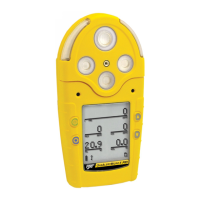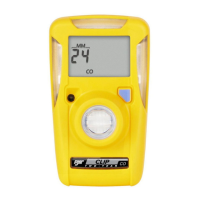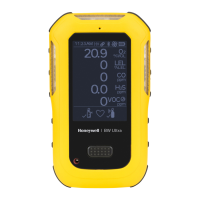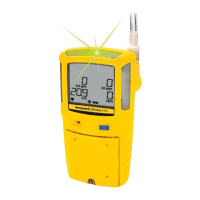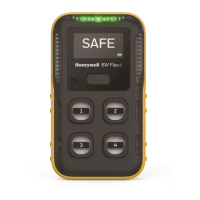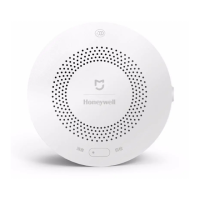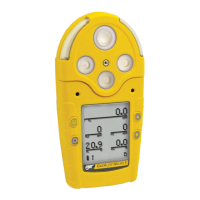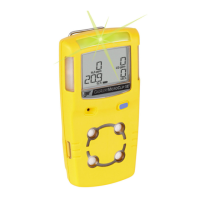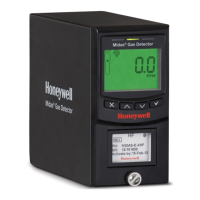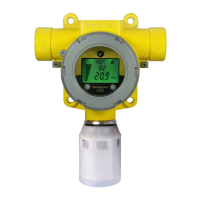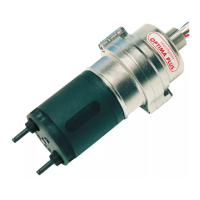Do you have a question about the Honeywell BW Technologies GasAlert MicroClip XT and is the answer not in the manual?
Procedure to zero the gas detector sensors.
Critical warnings regarding lithium battery disposal, fire hazards, and misuse.
Essential safety guidelines for detector operation, component integrity, and servicing.
Guidelines for cleaning the detector and lists of products to avoid.
Identifies detector parts, included items, and configuration software.
Identifies and describes the physical parts of the detector.
Explains the various elements shown on the detector's LCD screen.
Details the actions performed by pressing the detector's pushbutton.
Describes startup tests, battery status, and self-test confirmations.
How alarm setpoints are displayed and the sensor and power test procedure.
Configuration for auto-zero and auto-calibration during startup.
How calibration status, overdue warnings, and IR lock are indicated.
How bump test failures and force bump prompts are displayed.
Indicates self-test results, low battery alarms, and backlight activation.
Procedure to properly turn off the gas detector.
Detailed instructions for installing the necessary configuration software.
Steps to connect and configure the detector using the IR Link.
How to access and configure detector identification and startup messages.
Settings for disabling sensors, calibration intervals, and bump intervals.
Setting low, high, TWA, and STEL alarm thresholds for sensors.
Configuring features like Latching Alarms, Safe Mode, and Stealth Mode.
Configuring options to enforce overdue calibration and bump tests.
Configuring visual and audible confirmation signals.
Configuring data logging frequency and detector display language.
Describes the audible, visual, and vibrator alarms for different gas levels.
Explains alarms for multiple gases, sensor failures, and low battery conditions.
Describes alarms for exceeding detection limits and automatic shutdown sequences.
How to view recorded gas exposure data.
Procedure to clear recorded TWA, STEL, and peak exposure data.
Explains the conditions for various gas alarms (Low, High, TWA, STEL, etc.).
Default setpoints and how to change them, plus stopping alarms.
How sensor failures and low battery conditions are indicated.
Reasons for automatic deactivation and the sequence it follows.
Guidelines for using gas cylinders and connecting for a bump test.
Best practices, diagnostics, and recommended gas mixtures for calibration.
Steps to connect the cylinder and set span concentrations for calibration.
Step-by-step instructions to perform calibration using the IR Link.
How auto-zero and auto-span calibration functions work and their indications.
Indications of span success/failure and calibration due date resets.
Steps to verify calibration accuracy using a different gas.
Details on recorded datalogs and event logs.
How to transfer data and the necessary software applications.
General maintenance, cleaning, and critical battery safety guidelines.
Steps for connecting the charger, indicators, and charging times.
Safety precautions and procedures for replacing sensors and filters.
Steps to remove the back shell and reassemble the detector.
Solutions for issues during detector startup and activation self-tests.
Solutions for common operational issues like inaccurate readings or no alarms.
Solutions for charging issues and features not operating correctly.
Troubleshooting specific error screens encountered during startup.
Solutions for errors encountered during the calibration process.
Lists part numbers for sensors, regulators, and calibration gas cylinders.
Lists part numbers for chargers, datalogging, and carrying accessories.
Lists replacement part numbers for specific XT, XL, and X3 models.
Details on detector dimensions, weight, environment, and gas detection ranges.
Lists alarm types, user options, and battery operating times.
Manufacturer details, certifications, error limits, and warranty information.
Specifications for the datalogger and compliance with EMI standards.
Procedure to zero the gas detector sensors.
Critical warnings regarding lithium battery disposal, fire hazards, and misuse.
Essential safety guidelines for detector operation, component integrity, and servicing.
Guidelines for cleaning the detector and lists of products to avoid.
Identifies detector parts, included items, and configuration software.
Identifies and describes the physical parts of the detector.
Explains the various elements shown on the detector's LCD screen.
Details the actions performed by pressing the detector's pushbutton.
Describes startup tests, battery status, and self-test confirmations.
How alarm setpoints are displayed and the sensor and power test procedure.
Configuration for auto-zero and auto-calibration during startup.
How calibration status, overdue warnings, and IR lock are indicated.
How bump test failures and force bump prompts are displayed.
Indicates self-test results, low battery alarms, and backlight activation.
Procedure to properly turn off the gas detector.
Detailed instructions for installing the necessary configuration software.
Steps to connect and configure the detector using the IR Link.
How to access and configure detector identification and startup messages.
Settings for disabling sensors, calibration intervals, and bump intervals.
Setting low, high, TWA, and STEL alarm thresholds for sensors.
Configuring features like Latching Alarms, Safe Mode, and Stealth Mode.
Configuring options to enforce overdue calibration and bump tests.
Configuring visual and audible confirmation signals.
Configuring data logging frequency and detector display language.
Describes the audible, visual, and vibrator alarms for different gas levels.
Explains alarms for multiple gases, sensor failures, and low battery conditions.
Describes alarms for exceeding detection limits and automatic shutdown sequences.
How to view recorded gas exposure data.
Procedure to clear recorded TWA, STEL, and peak exposure data.
Explains the conditions for various gas alarms (Low, High, TWA, STEL, etc.).
Default setpoints and how to change them, plus stopping alarms.
How sensor failures and low battery conditions are indicated.
Reasons for automatic deactivation and the sequence it follows.
Guidelines for using gas cylinders and connecting for a bump test.
Best practices, diagnostics, and recommended gas mixtures for calibration.
Steps to connect the cylinder and set span concentrations for calibration.
Step-by-step instructions to perform calibration using the IR Link.
How auto-zero and auto-span calibration functions work and their indications.
Indications of span success/failure and calibration due date resets.
Steps to verify calibration accuracy using a different gas.
Details on recorded datalogs and event logs.
How to transfer data and the necessary software applications.
General maintenance, cleaning, and critical battery safety guidelines.
Steps for connecting the charger, indicators, and charging times.
Safety precautions and procedures for replacing sensors and filters.
Steps to remove the back shell and reassemble the detector.
Solutions for issues during detector startup and activation self-tests.
Solutions for common operational issues like inaccurate readings or no alarms.
Solutions for charging issues and features not operating correctly.
Troubleshooting specific error screens encountered during startup.
Solutions for errors encountered during the calibration process.
Lists part numbers for sensors, regulators, and calibration gas cylinders.
Lists part numbers for chargers, datalogging, and carrying accessories.
Lists replacement part numbers for specific XT, XL, and X3 models.
Details on detector dimensions, weight, environment, and gas detection ranges.
Lists alarm types, user options, and battery operating times.
Manufacturer details, certifications, error limits, and warranty information.
Specifications for the datalogger and compliance with EMI standards.
| Display | LCD |
|---|---|
| Alarms | Visual, audible, and vibrating alarms |
| Operating Temperature Range | -20°C to 50°C (-4°F to 122°F) |
| Sensor Types | Electrochemical |
| Target Gas | O2, CO, H2S, LEL |
| Detection Gases | Oxygen (O2), Carbon Monoxide (CO), Hydrogen Sulfide (H2S), Lower Explosive Limit (LEL) |
| Resolution | 1 ppm for CO and H2S; 0.1% for LEL; 0.1% for O2 |
| Certifications | ATEX, UL, CSA |
| Measurement Range | O2: 0-30%, CO: 0-500 ppm, H2S: 0-100 ppm, LEL: 0-100% Vol. |
| Humidity Range | 5% to 95% RH (non-condensing) |
